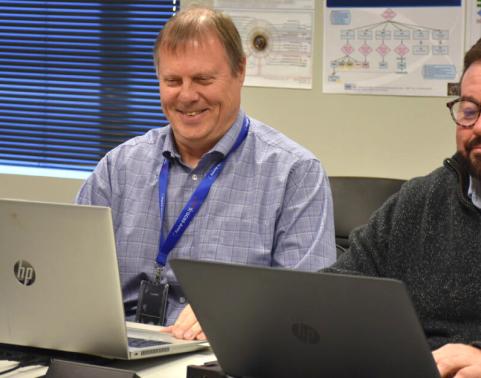GCSS-Army software testing: a look back at the Agile way ahead

Well before the Army’s ongoing transition to Agile software development, U.S. Army Program Executive Office Enterprise Information Systems’ (PEO EIS) Global Combat Support System – Army (GCSS-Army) product office saw a need to shorten the software testing timeline.
GCSS-Army is the Army’s tactical logistics and financial management information enterprise resource planning (ERP) solution, which serves as the tactical property accountability and financial management system of record for the Army. Up until around seven years ago, the GCSS-Army team at EIS had been conducting regression testing of the ERP software — tests to ensure that software changes don’t impact existing functionality — in a manual fashion. This manual process was costly and time-consuming.
In 2017, when team members completed the full system deployment of GCSS-Army’s Increment 1 solution, the GCSS-Army product manager decided to improve acquisition test and evaluation for future increments by automating the regression testing process.
One of the key advantages to automating tests is that once created, they can be conducted repeatedly at no additional cost and are much faster than manual tests — reducing the time required to run repetitive tests from days to hours.
Before kicking off the automation process, the GCSS-Army team developed a strategy to overcome the resource-related challenges involved with manual testing. The solutions to these challenges included:
-
Reducing the considerable number of hours for manual regression testing for each release
-
Reducing the number of personnel needed to execute manual materiel requirements planning (MRP) testing
-
Creating a library of regression tests for each release
-
Developing targeted regression testing to test only what is required
-
Developing a scalable automation solution to grow the automation test library without adding excess testing hours
Next, the GCSS-Army test team developed the actual automation solution using commercial off-the-shelf automation software. Within the software, team members wrote extensive code to reduce the amount of personnel and hours required to complete regression testing.
The team then developed 500 automated tests to determine whether various features of the GCSS-Army system would perform as expected. They confirmed it satisfied all required standards, guidelines and customer needs.
Automation of the regression testing process produced immediate results. In the past, manual MRP testing had taken approximately 700 person-hours, while GCSS-Army’s newly automated MRP test solution decreased the time required to approximately 100 person-hours. This represented a significant reduction in test effort while ensuring consistent execution.
The net result was an increase in speed, efficiency, consistency and accuracy — four significant outcomes consistent with the Agile software development process.
Kevin Curry, project manager for Defense Integrated Business Systems (DIBS) at PEO EIS, believes GCSS-Army’s early work in shortening the software testing timeline was forward-thinking.
“Looking back, the GCSS-Army Increment 1 solution was a great example of how the product office’s test automation project applied Agile frameworks and methodologies on their pathways to implementing true Agile software development,” said Curry. “The tremendous results of the automated MRP regression testing showed the great potential benefits to the Army of implementing Agile.”
As of early 2023, GCSS-Army had developed 796 automated test cases (129 MRP; 667 regression automation) compared to zero when the test automation effort started. The team’s goals are to continue creating, refining and leveraging test automation to provide an Agile test environment in which test executions can increasingly supplement Agile sprint changes within cost, schedule and scope. The team also aims to achieve a comprehensive, efficient and reliable testing process that supports Agile development practices.
Moving forward, the GCSS-Army team plans to procure newer tools that will enable more comprehensive automated testing, including unit, regression, remote unattended and Agile testing.
“As we look to the future,” said Curry, “the GCSS-Army product office is working with other Army management information systems’ project and product management offices to employ new tools and to streamline processes — including for test and evaluation — as part of the overall Agile development strategy.”
Related News
-
GFEBS pilot of SAFe Lean Business Case saves time, money for customers
June 11, 2025As part of U.S. Army Program Executive Office (PEO) Enterprise’s Agile transformation, which began in late 2022, the organization’s acquisition programs have been implementing Scaled Agile Framework® (SAFe®) principles. -
Army navigates challenges to deliver modernized GFEBS G-Invoicing solution
November 15, 2024U.S. Army Program Executive Office (PEO) Enterprise and the Office of the Assistant Secretary of the Army for Financial Management & Comptroller (ASA-FM&C) are continuing to modernize the General Fund Enterprise Business System (GFEBS). -
Army reaches another key milestone with its modernized contract writing system
November 4, 2024U.S. Army Program Executive Office (PEO) Enterprise and the Office of the Deputy Assistant Secretary of the Army for Procurement (ODASA(P)) recently achieved another key milestone with the modernized Army Contract Writing System (ACWS).
Work for Us
Join a winning team! Search for job opportunities with PEO Enterprise.
Work with Us
Help support important missions. Explore ways your company can work with PEO Enterprise.